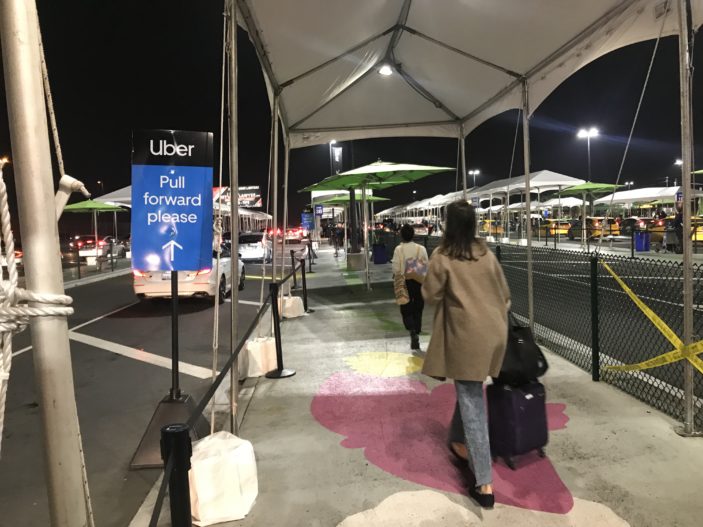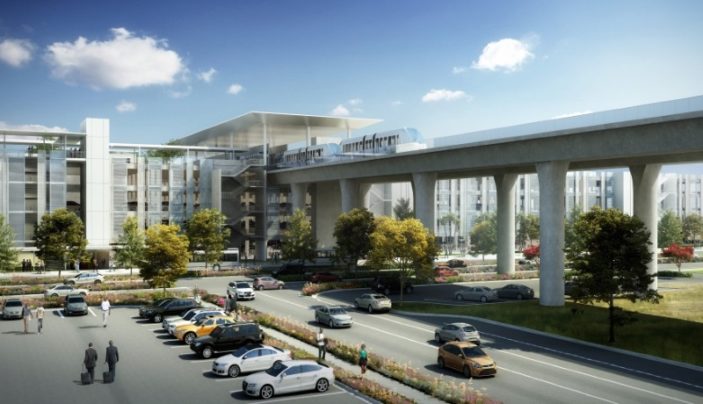
The Los Angeles International Airport (LAX) has been undergoing a number of welcome changes over the last couple of years: long overdue upgraded terminals, new walkways connecting terminals post-security, and a wide range of enhancements designed to make the experience of being at one of the world’s busiest airports all that better. Higher quality food, faster security options, enhanced lounges. Once considered among the world’s worst major airports, LAX is now leading the way in showing what a modern airport should look like in North America.
And then there are the new transportation options. Some, like the expansion of the FlyAway bus network to Hollywood and Long Beach happened in the middle of the last decade, offering an affordable alternative to get out of the LAX area; the service has long been running to Van Nuys (since 1975) and Union Station (since 2006).
Then, work officially began last year on a new “Automated People Mover” system set to open in 2023, five years before the city is due to host the Summer Olympics.
The free rail service will run 24/7, every two minutes, with 6 stops across 2.25 miles that will make it easier for passengers to get around LAX. In addition to three stops throughout the terminals, there will be a new consolidated car rental building, that by combining all the nearby car rental centres, will also open up a wide array of real estate in the LAX surrounds. On the other end will be a new parking structure and drop off point, the Intermodal Transportation Facility (ITF – West).
And the final stop will be at a Metro train station, finally connecting LAX passengers to a rail service. It’s all about relieving pressure on the traffic, and, ideally making the experience at the airport a more efficient experience for everyone.

In what may prove to be something of a test to see how passengers fair when it comes to leaving the terminal area for their transport options (and is a result of the People Mover construction itself), at the end of last year LAX opened their new LAX-it system (pronounced “L.A. Exit”), taking rideshare passengers and taxi customers to a new pick up zone next to Terminal 1, via a free shuttle bus.
When it first opened at the start of November, “chaos” was reported – though when I passed through LAX around that time, I didn’t even notice it, as I picked up my ride-share service as normal. Having passed through LAX last week, however, the services have now been officially banned from curbside pickup unless it’s a Limo service (e.g. Uber Black), and the apps give you a code instead of a pick up point, which you will show to the first available driver when you get to the LAX-it area.
This “code” system is showing up at airports around the world, and treats ride share services similarly to Taxis, where you lineup for them, jump in the first available service, but then after showing them the code and they enter it, the app treats it as a ride like any other. It works well, and expect it to become the norm as things move forward. Few airports though are shuttling you away from the airport to use the system. But few airports see the traffic problems that LAX has over the years. And anyone who has picked up a rideshare from the terminals know how difficult it can be to find your driver, and for them to find you. Not to mention the added cost of waiting in the traffic as you pass by the other terminals.
As of my experience in mid-February, three months in the system seems to be moving efficiently. Any signs of “chaos” were limited to the general confusion or frustration from travellers (myself included) who didn’t expect it and saw it initially as an added delay to getting out of the airport.
And there’s no denying that having to jump on a bus is a massive pain. The buses are pretty standard transit buses and don’t have ample room for luggage. But, I was impressed to see that when I jumped on at Terminal 2, they didn’t overcrowd the bus before we left, nor did they stop at any other Terminals to pick up passengers. Though it took us a while to get through traffic to get there – it was less than 10 minutes. I was expecting a lot worse. And there was one waiting for me as soon as I walked out the door with my luggage.
Staff were friendly and helpful and were able to answer any questions you had about the service. Once there, the line for the Uber moved quickly and I was in an Uber a little more than 15 minutes after I had picked up by baggage. And once in the Uber, it was able to get out of the LAX area in the blink of an eye. If you wanted a Lyft or a Taxi, there were separate queues for these services.
And ultimately that’s where the time is saved – on the “L.A. Exit” itself. While the overall process to get an Uber took a bit longer than the old system, and having to jump on a bus is less preferred to standing on a curb, by the time we hit the freeway there was no question that the system is going to be the more efficient way moving forward. And those who can’t fathom the idea of jumping on a bus to get to their service, the more luxury options remain for those who have the money to spend on it.
It’s also worth mentioning that Uber Pool (and equivalents) remain an option – there is a specific pick up area for that. I can’t speak to how that works – though having gotten an Uber Pool to the airport the next day, I can confirm that drop off procedures at the airport remain the same.
For more details about LAX-it, head HERE.
